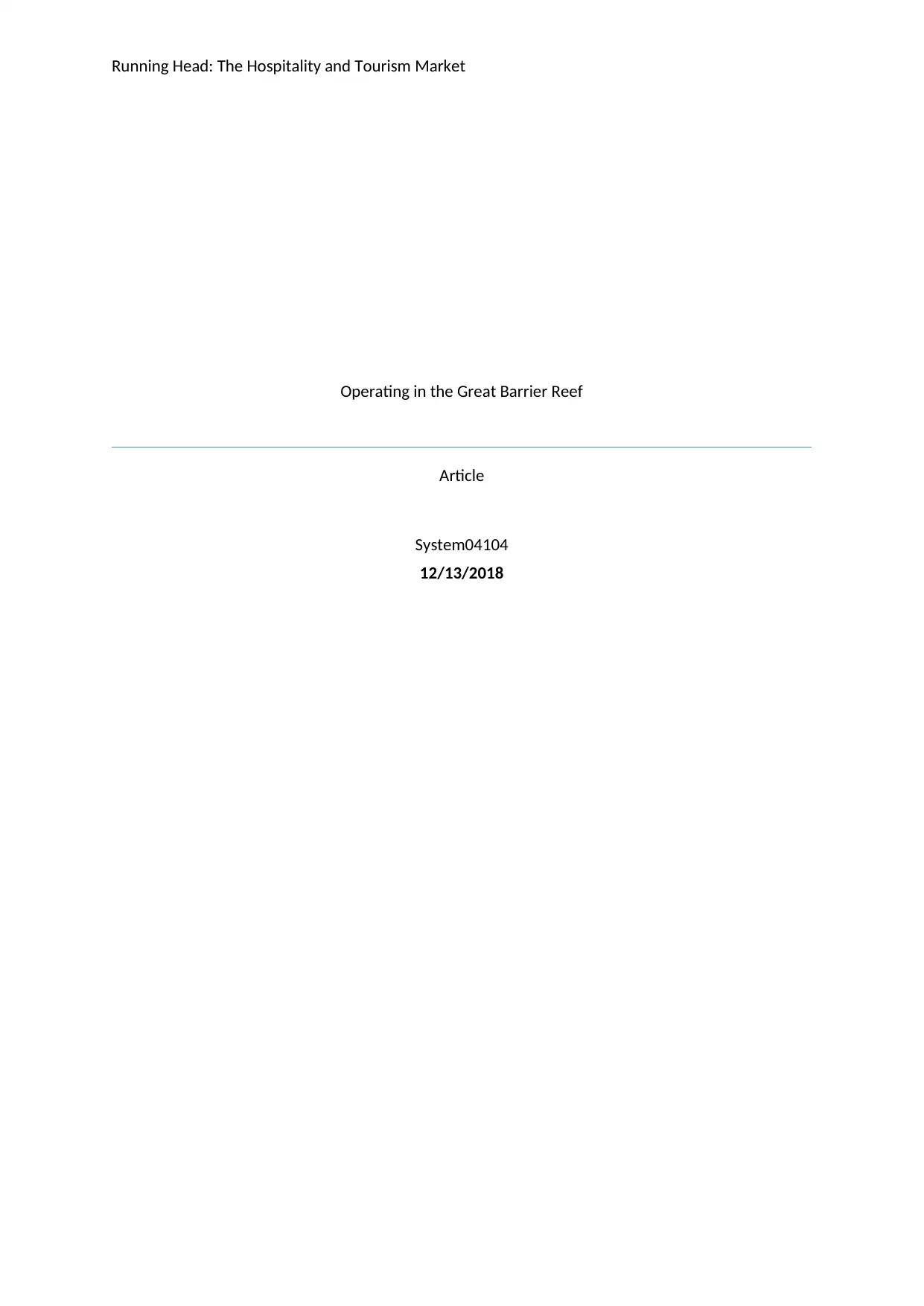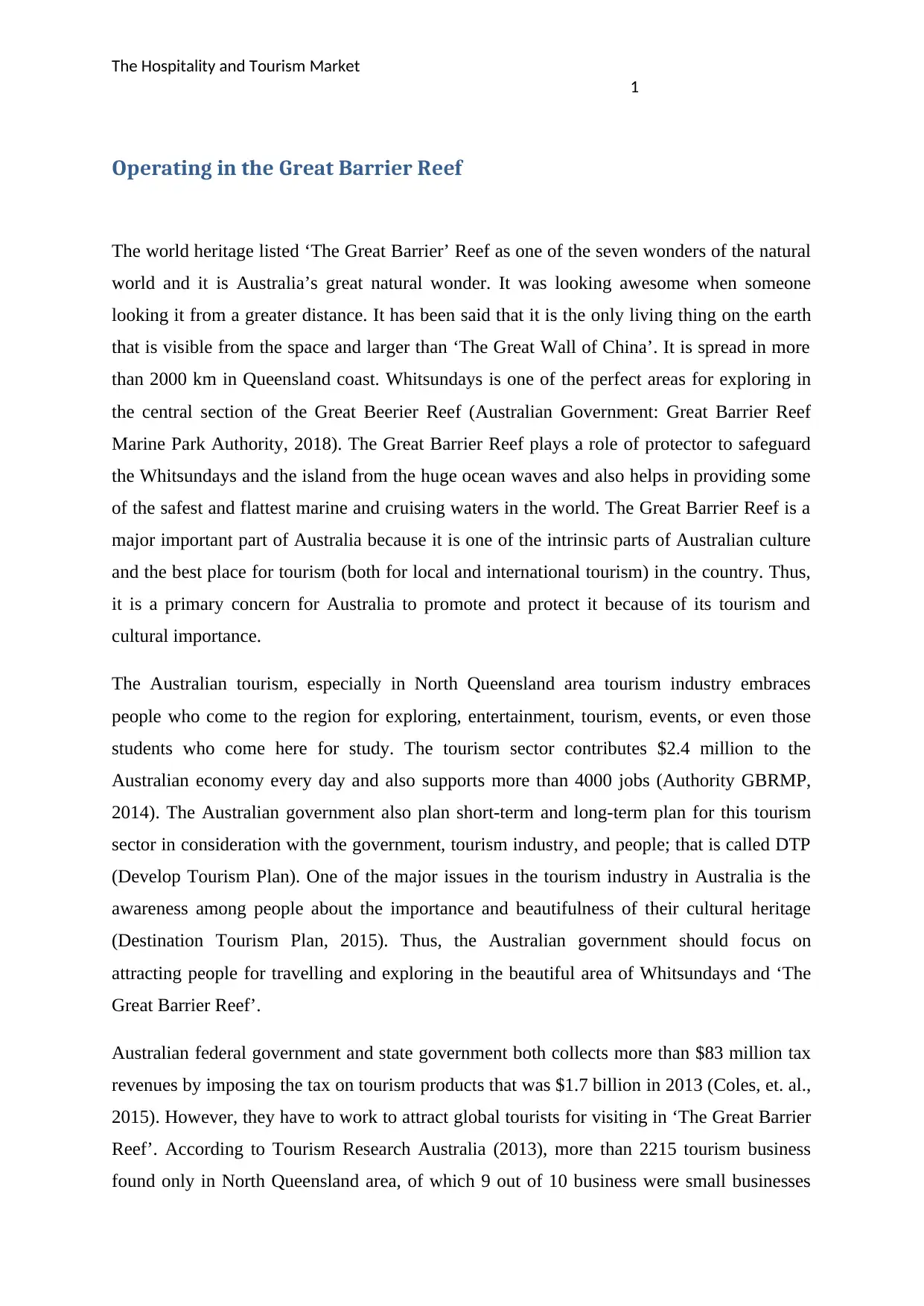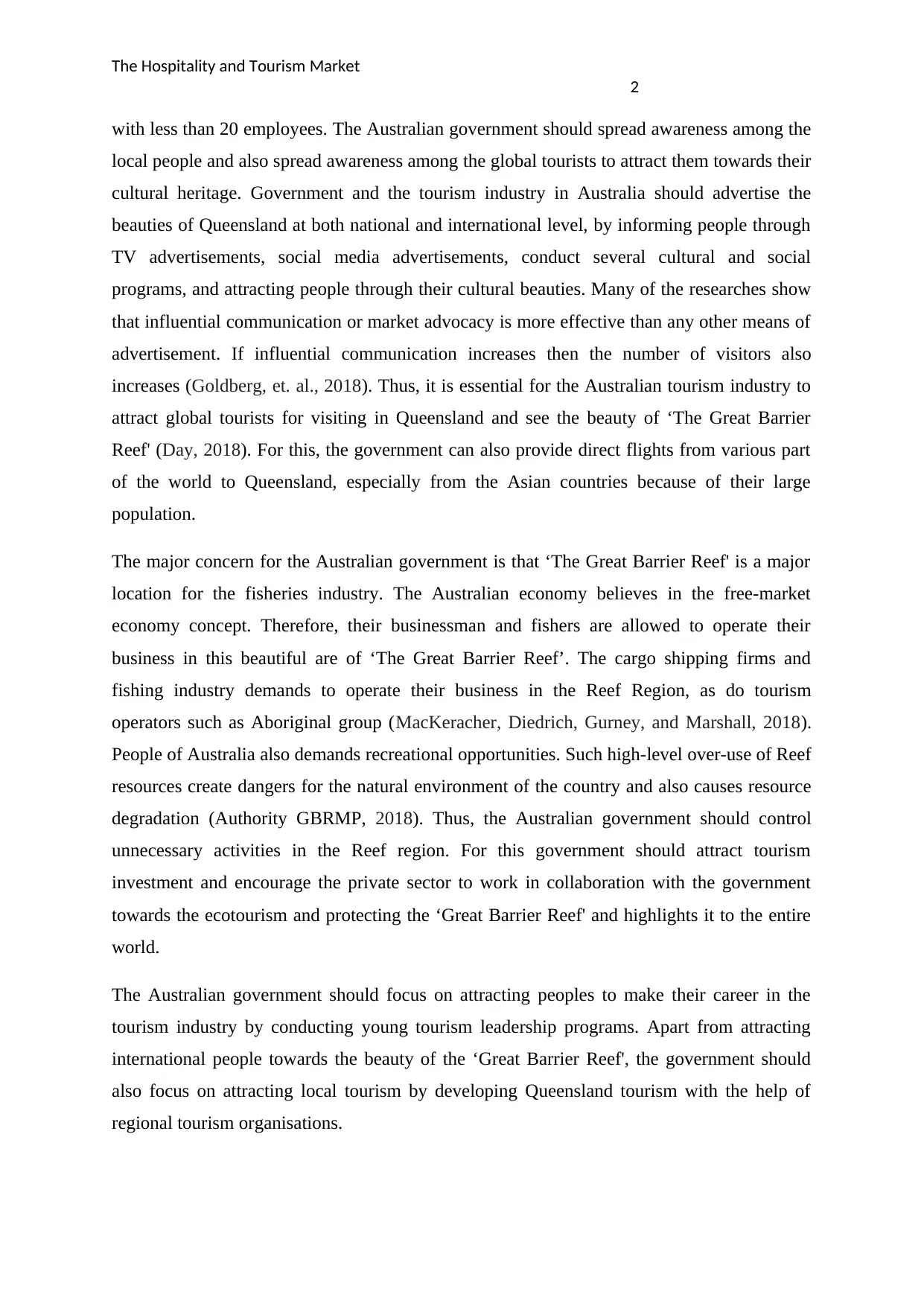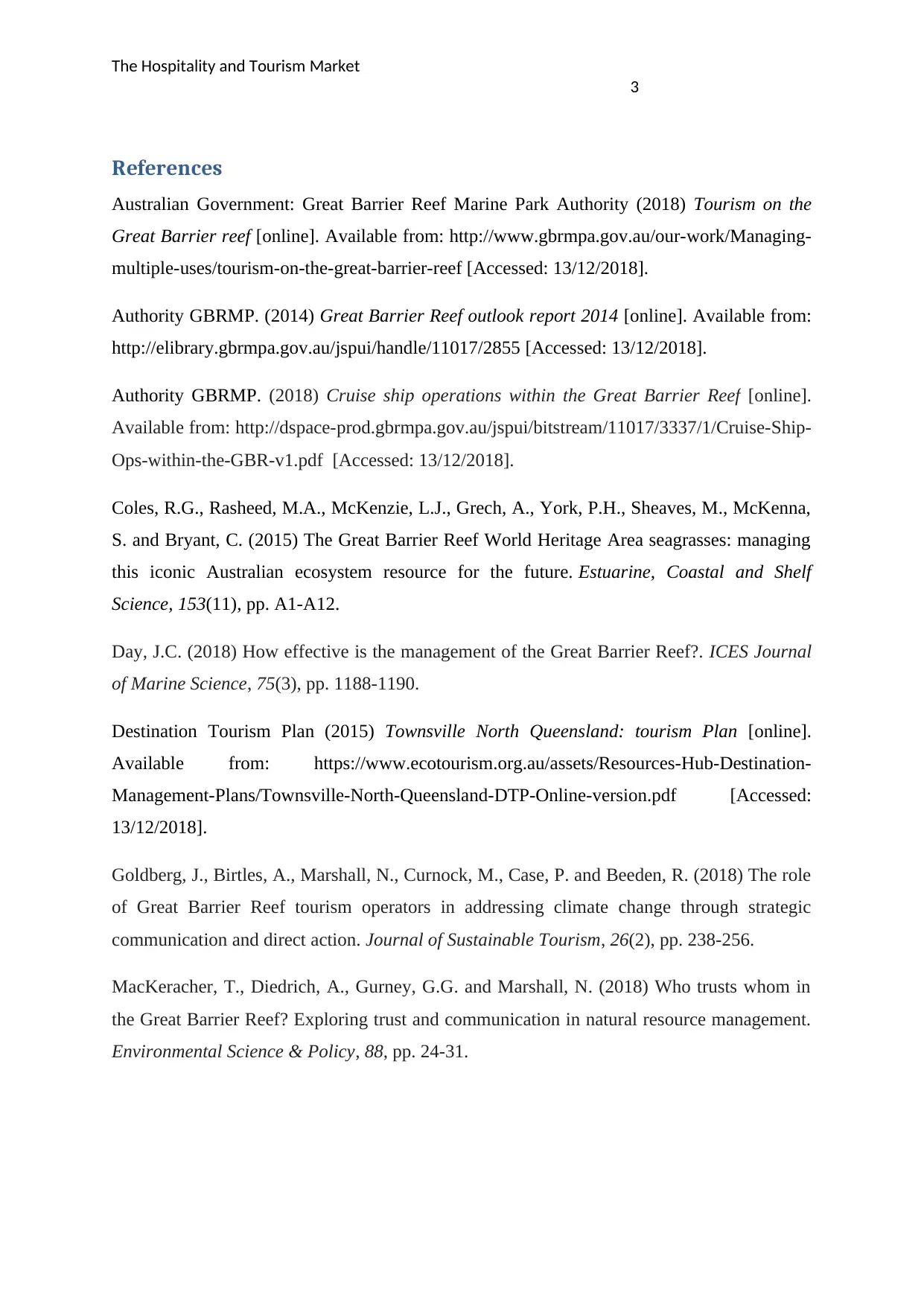The Hospitality and Tourism Market Operating in the Great Barrier Reef
VerifiedAdded on 2023/05/27
|4
|1270
|333
Report
AI Summary
This report provides an analysis of the hospitality and tourism market operating within the Great Barrier Reef, a UNESCO World Heritage site and a significant contributor to the Australian economy. It highlights the reef's importance as a tourism destination, attracting both domestic and international visitors and supporting thousands of jobs. The report emphasizes the need for sustainable tourism practices to protect the reef's natural environment from overuse and degradation caused by industries such as fishing and cargo shipping. It suggests strategies for promoting ecotourism, attracting tourism investment, and developing regional tourism organizations to enhance local tourism. The report also underscores the importance of raising awareness about the reef's cultural and economic value through effective communication and marketing efforts, encouraging both local and global tourists to visit and appreciate this natural wonder while ensuring its long-term preservation.

Running Head: The Hospitality and Tourism Market
Operating in the Great Barrier Reef
Article
System04104
12/13/2018
Operating in the Great Barrier Reef
Article
System04104
12/13/2018
Paraphrase This Document
Need a fresh take? Get an instant paraphrase of this document with our AI Paraphraser

The Hospitality and Tourism Market
1
Operating in the Great Barrier Reef
The world heritage listed ‘The Great Barrier’ Reef as one of the seven wonders of the natural
world and it is Australia’s great natural wonder. It was looking awesome when someone
looking it from a greater distance. It has been said that it is the only living thing on the earth
that is visible from the space and larger than ‘The Great Wall of China’. It is spread in more
than 2000 km in Queensland coast. Whitsundays is one of the perfect areas for exploring in
the central section of the Great Beerier Reef (Australian Government: Great Barrier Reef
Marine Park Authority, 2018). The Great Barrier Reef plays a role of protector to safeguard
the Whitsundays and the island from the huge ocean waves and also helps in providing some
of the safest and flattest marine and cruising waters in the world. The Great Barrier Reef is a
major important part of Australia because it is one of the intrinsic parts of Australian culture
and the best place for tourism (both for local and international tourism) in the country. Thus,
it is a primary concern for Australia to promote and protect it because of its tourism and
cultural importance.
The Australian tourism, especially in North Queensland area tourism industry embraces
people who come to the region for exploring, entertainment, tourism, events, or even those
students who come here for study. The tourism sector contributes $2.4 million to the
Australian economy every day and also supports more than 4000 jobs (Authority GBRMP,
2014). The Australian government also plan short-term and long-term plan for this tourism
sector in consideration with the government, tourism industry, and people; that is called DTP
(Develop Tourism Plan). One of the major issues in the tourism industry in Australia is the
awareness among people about the importance and beautifulness of their cultural heritage
(Destination Tourism Plan, 2015). Thus, the Australian government should focus on
attracting people for travelling and exploring in the beautiful area of Whitsundays and ‘The
Great Barrier Reef’.
Australian federal government and state government both collects more than $83 million tax
revenues by imposing the tax on tourism products that was $1.7 billion in 2013 (Coles, et. al.,
2015). However, they have to work to attract global tourists for visiting in ‘The Great Barrier
Reef’. According to Tourism Research Australia (2013), more than 2215 tourism business
found only in North Queensland area, of which 9 out of 10 business were small businesses
1
Operating in the Great Barrier Reef
The world heritage listed ‘The Great Barrier’ Reef as one of the seven wonders of the natural
world and it is Australia’s great natural wonder. It was looking awesome when someone
looking it from a greater distance. It has been said that it is the only living thing on the earth
that is visible from the space and larger than ‘The Great Wall of China’. It is spread in more
than 2000 km in Queensland coast. Whitsundays is one of the perfect areas for exploring in
the central section of the Great Beerier Reef (Australian Government: Great Barrier Reef
Marine Park Authority, 2018). The Great Barrier Reef plays a role of protector to safeguard
the Whitsundays and the island from the huge ocean waves and also helps in providing some
of the safest and flattest marine and cruising waters in the world. The Great Barrier Reef is a
major important part of Australia because it is one of the intrinsic parts of Australian culture
and the best place for tourism (both for local and international tourism) in the country. Thus,
it is a primary concern for Australia to promote and protect it because of its tourism and
cultural importance.
The Australian tourism, especially in North Queensland area tourism industry embraces
people who come to the region for exploring, entertainment, tourism, events, or even those
students who come here for study. The tourism sector contributes $2.4 million to the
Australian economy every day and also supports more than 4000 jobs (Authority GBRMP,
2014). The Australian government also plan short-term and long-term plan for this tourism
sector in consideration with the government, tourism industry, and people; that is called DTP
(Develop Tourism Plan). One of the major issues in the tourism industry in Australia is the
awareness among people about the importance and beautifulness of their cultural heritage
(Destination Tourism Plan, 2015). Thus, the Australian government should focus on
attracting people for travelling and exploring in the beautiful area of Whitsundays and ‘The
Great Barrier Reef’.
Australian federal government and state government both collects more than $83 million tax
revenues by imposing the tax on tourism products that was $1.7 billion in 2013 (Coles, et. al.,
2015). However, they have to work to attract global tourists for visiting in ‘The Great Barrier
Reef’. According to Tourism Research Australia (2013), more than 2215 tourism business
found only in North Queensland area, of which 9 out of 10 business were small businesses

The Hospitality and Tourism Market
2
with less than 20 employees. The Australian government should spread awareness among the
local people and also spread awareness among the global tourists to attract them towards their
cultural heritage. Government and the tourism industry in Australia should advertise the
beauties of Queensland at both national and international level, by informing people through
TV advertisements, social media advertisements, conduct several cultural and social
programs, and attracting people through their cultural beauties. Many of the researches show
that influential communication or market advocacy is more effective than any other means of
advertisement. If influential communication increases then the number of visitors also
increases (Goldberg, et. al., 2018). Thus, it is essential for the Australian tourism industry to
attract global tourists for visiting in Queensland and see the beauty of ‘The Great Barrier
Reef' (Day, 2018). For this, the government can also provide direct flights from various part
of the world to Queensland, especially from the Asian countries because of their large
population.
The major concern for the Australian government is that ‘The Great Barrier Reef' is a major
location for the fisheries industry. The Australian economy believes in the free-market
economy concept. Therefore, their businessman and fishers are allowed to operate their
business in this beautiful are of ‘The Great Barrier Reef’. The cargo shipping firms and
fishing industry demands to operate their business in the Reef Region, as do tourism
operators such as Aboriginal group (MacKeracher, Diedrich, Gurney, and Marshall, 2018).
People of Australia also demands recreational opportunities. Such high-level over-use of Reef
resources create dangers for the natural environment of the country and also causes resource
degradation (Authority GBRMP, 2018). Thus, the Australian government should control
unnecessary activities in the Reef region. For this government should attract tourism
investment and encourage the private sector to work in collaboration with the government
towards the ecotourism and protecting the ‘Great Barrier Reef' and highlights it to the entire
world.
The Australian government should focus on attracting peoples to make their career in the
tourism industry by conducting young tourism leadership programs. Apart from attracting
international people towards the beauty of the ‘Great Barrier Reef', the government should
also focus on attracting local tourism by developing Queensland tourism with the help of
regional tourism organisations.
2
with less than 20 employees. The Australian government should spread awareness among the
local people and also spread awareness among the global tourists to attract them towards their
cultural heritage. Government and the tourism industry in Australia should advertise the
beauties of Queensland at both national and international level, by informing people through
TV advertisements, social media advertisements, conduct several cultural and social
programs, and attracting people through their cultural beauties. Many of the researches show
that influential communication or market advocacy is more effective than any other means of
advertisement. If influential communication increases then the number of visitors also
increases (Goldberg, et. al., 2018). Thus, it is essential for the Australian tourism industry to
attract global tourists for visiting in Queensland and see the beauty of ‘The Great Barrier
Reef' (Day, 2018). For this, the government can also provide direct flights from various part
of the world to Queensland, especially from the Asian countries because of their large
population.
The major concern for the Australian government is that ‘The Great Barrier Reef' is a major
location for the fisheries industry. The Australian economy believes in the free-market
economy concept. Therefore, their businessman and fishers are allowed to operate their
business in this beautiful are of ‘The Great Barrier Reef’. The cargo shipping firms and
fishing industry demands to operate their business in the Reef Region, as do tourism
operators such as Aboriginal group (MacKeracher, Diedrich, Gurney, and Marshall, 2018).
People of Australia also demands recreational opportunities. Such high-level over-use of Reef
resources create dangers for the natural environment of the country and also causes resource
degradation (Authority GBRMP, 2018). Thus, the Australian government should control
unnecessary activities in the Reef region. For this government should attract tourism
investment and encourage the private sector to work in collaboration with the government
towards the ecotourism and protecting the ‘Great Barrier Reef' and highlights it to the entire
world.
The Australian government should focus on attracting peoples to make their career in the
tourism industry by conducting young tourism leadership programs. Apart from attracting
international people towards the beauty of the ‘Great Barrier Reef', the government should
also focus on attracting local tourism by developing Queensland tourism with the help of
regional tourism organisations.
⊘ This is a preview!⊘
Do you want full access?
Subscribe today to unlock all pages.

Trusted by 1+ million students worldwide

The Hospitality and Tourism Market
3
References
Australian Government: Great Barrier Reef Marine Park Authority (2018) Tourism on the
Great Barrier reef [online]. Available from: http://www.gbrmpa.gov.au/our-work/Managing-
multiple-uses/tourism-on-the-great-barrier-reef [Accessed: 13/12/2018].
Authority GBRMP. (2014) Great Barrier Reef outlook report 2014 [online]. Available from:
http://elibrary.gbrmpa.gov.au/jspui/handle/11017/2855 [Accessed: 13/12/2018].
Authority GBRMP. (2018) Cruise ship operations within the Great Barrier Reef [online].
Available from: http://dspace-prod.gbrmpa.gov.au/jspui/bitstream/11017/3337/1/Cruise-Ship-
Ops-within-the-GBR-v1.pdf [Accessed: 13/12/2018].
Coles, R.G., Rasheed, M.A., McKenzie, L.J., Grech, A., York, P.H., Sheaves, M., McKenna,
S. and Bryant, C. (2015) The Great Barrier Reef World Heritage Area seagrasses: managing
this iconic Australian ecosystem resource for the future. Estuarine, Coastal and Shelf
Science, 153(11), pp. A1-A12.
Day, J.C. (2018) How effective is the management of the Great Barrier Reef?. ICES Journal
of Marine Science, 75(3), pp. 1188-1190.
Destination Tourism Plan (2015) Townsville North Queensland: tourism Plan [online].
Available from: https://www.ecotourism.org.au/assets/Resources-Hub-Destination-
Management-Plans/Townsville-North-Queensland-DTP-Online-version.pdf [Accessed:
13/12/2018].
Goldberg, J., Birtles, A., Marshall, N., Curnock, M., Case, P. and Beeden, R. (2018) The role
of Great Barrier Reef tourism operators in addressing climate change through strategic
communication and direct action. Journal of Sustainable Tourism, 26(2), pp. 238-256.
MacKeracher, T., Diedrich, A., Gurney, G.G. and Marshall, N. (2018) Who trusts whom in
the Great Barrier Reef? Exploring trust and communication in natural resource management.
Environmental Science & Policy, 88, pp. 24-31.
3
References
Australian Government: Great Barrier Reef Marine Park Authority (2018) Tourism on the
Great Barrier reef [online]. Available from: http://www.gbrmpa.gov.au/our-work/Managing-
multiple-uses/tourism-on-the-great-barrier-reef [Accessed: 13/12/2018].
Authority GBRMP. (2014) Great Barrier Reef outlook report 2014 [online]. Available from:
http://elibrary.gbrmpa.gov.au/jspui/handle/11017/2855 [Accessed: 13/12/2018].
Authority GBRMP. (2018) Cruise ship operations within the Great Barrier Reef [online].
Available from: http://dspace-prod.gbrmpa.gov.au/jspui/bitstream/11017/3337/1/Cruise-Ship-
Ops-within-the-GBR-v1.pdf [Accessed: 13/12/2018].
Coles, R.G., Rasheed, M.A., McKenzie, L.J., Grech, A., York, P.H., Sheaves, M., McKenna,
S. and Bryant, C. (2015) The Great Barrier Reef World Heritage Area seagrasses: managing
this iconic Australian ecosystem resource for the future. Estuarine, Coastal and Shelf
Science, 153(11), pp. A1-A12.
Day, J.C. (2018) How effective is the management of the Great Barrier Reef?. ICES Journal
of Marine Science, 75(3), pp. 1188-1190.
Destination Tourism Plan (2015) Townsville North Queensland: tourism Plan [online].
Available from: https://www.ecotourism.org.au/assets/Resources-Hub-Destination-
Management-Plans/Townsville-North-Queensland-DTP-Online-version.pdf [Accessed:
13/12/2018].
Goldberg, J., Birtles, A., Marshall, N., Curnock, M., Case, P. and Beeden, R. (2018) The role
of Great Barrier Reef tourism operators in addressing climate change through strategic
communication and direct action. Journal of Sustainable Tourism, 26(2), pp. 238-256.
MacKeracher, T., Diedrich, A., Gurney, G.G. and Marshall, N. (2018) Who trusts whom in
the Great Barrier Reef? Exploring trust and communication in natural resource management.
Environmental Science & Policy, 88, pp. 24-31.
1 out of 4
Related Documents
Your All-in-One AI-Powered Toolkit for Academic Success.
+13062052269
info@desklib.com
Available 24*7 on WhatsApp / Email
![[object Object]](/_next/static/media/star-bottom.7253800d.svg)
Unlock your academic potential
Copyright © 2020–2025 A2Z Services. All Rights Reserved. Developed and managed by ZUCOL.





